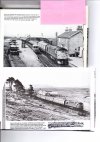That matches my recollection.
'67 timetable shows the buffet on both morning trains going to Thurso, but by '73 both trains took the buffet to Wick - I have no detail for the years in between.
There was a lot of mail and parcels plus newspapers going by rail - there were of course no couriers back then, the Post Office took the lot. And a quite a few vans on the morning Kyle too. I have no idea how well they were loaded on either route but I do recall quantities being unloaded at most stations.
All the mail etc for the North West was conveyed to Lairg, and on the Kyle line various outlying areas would by detrained at Garve, Achnasheen and Strathcarron.
There are published photos of the north train with 4 BGs on the front, I'll see if I can locate one.
The overnight attached 6 x BG at Perth as well as bringing two from Queen St and one in the Edinburgh portion.
I always thought the arrangement at Balnacra was quite cute, in other areas crossing keepers often had a small ground frame with signals - one even survives today at Norbury Crossing on the Buxton line although there the frame is inside a building. I'd guess that level of expenditure may have been took much for the Dingwall and Skye Railway although I am trying to remember what the arrangement was on the Kyle line level crossing in Dingwall, I think it had signals.
I can’t remember what happened on those crossings west of Dingwall. Were they not automated quite early if I remember? I seem to think that Achterneed (which crossed only a minor road) was an open crossing with no gates at all until it became an AOCL in the 1980s (probably at the same time as Balnacra). Strathcarron crossing had lifting barriers and lights controlled from the signal box from the early 70s onwards, and became an ABCL operated by a plunger when the signal box closed. Garve did not have a level crossing until 1989 (when it replaced a weak and narrow bridge)- this has always been an ABCL I think. Blackwood level crossing between Balnacra and Strathcarron, and Duirinish level crossing were UWCs (user-worked) until 2007 and 2014 respectively, I seem to remember. Apart from that, I can’t think of any other crossings on the line. The Balnacra crossing keeper in the 70s and 80s was an artist in his spare time, I seem to recall.
If you’re familiar with the BR Motive Power Panorama book from the late 1970s, you’ll see a picture of 26034 at Golspie with the northbound 06.15 Inverness to Wick/Thurso with 4 BGs at the front; this picture must have been taken in/around 1978/9.
Garve back then served as the railhead for a large area of northern Ross-shire (specifically Dundonnell, Loch Broom, Ullapool and the Wester Ross Coast from Little Loch Broom as far as the Sutherland county march). Achnasheen was the railhead for Kinlochewe, Torridon, Diabaig, Gairloch, Poolewe, Aultbea, Laide and the surrounding districts, while Strathcarron was the railhead for Lochcarron, the Applecross peninsula and Shieldaig. This is still reflected in the fact that these areas all have the same postcode (IV22 Achnasheen, IV23 Garve, IV54 Strathcarron), from the stations right out to the western townships, even though the mail no longer travels by train.
I have been wondering whether that is a ground-frame visible just beyond the gatepost, ‘below’ the flag. It could control the Distant signals, which would avoid the train having to slow down too much. The flag would be needed as, with the gates across the road, there is otherwise no positive indication of what the Distant is associated with: it is, in effect, replacing a Stop signal.
There’s a point, did it have distant signals? I can’t remember. Perhaps it did- but something tells me they were fixed. Then again, I’m not sure what makes me think that.
@Cheshire Scot will probably remember much better than I can.

